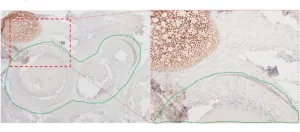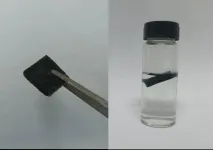(Press-News.org) UNIVERSITY PARK, Pa. — A patch of ocean in the North Atlantic is stubbornly cooling while much of the planet warms. This anomaly — dubbed the "cold blob" — has been linked to changes in ocean circulation, but a new study found changes in large-scale atmospheric patterns may play an equally important role, according to an international research team led by Penn State.
“People often think the atmosphere has a very short memory, but here we provide evidence that atmospheric circulation change is significant enough to induce some long-term impact on the climate system,” said corresponding author Laifang Li, assistant professor of meteorology and atmospheric science at Penn State.
Sea surface temperatures in the subpolar North Atlantic have decreased by about .7 degrees Fahrenheit over the last century, and a trend toward a more frequent positive phase of the North Atlantic Oscillation (NAO) may have contributed significantly, the scientists reported in the journal Climate Dynamics.
The NAO represents atmospheric circulation patterns involving a low-pressure system near Iceland and a high-pressure system near the Azores Islands, and it influences how westerly winds blow across the ocean. In the positive phase, both pressure systems are stronger than average, resulting in a stronger jet stream and a northward shift of the westerly winds, the scientists said.
“As the NAO becomes more positive, it intensifies the surface wind over the subpolar North Atlantic,” said Li, who is also an associate of the Earth and Environmental Systems Institute and a co-hire of the Institute for Computational and Data Sciences at Penn State. “When we would like to cool a cup of hot coffee, we stir the surface, and it promotes heat loss. That’s exactly what wind intensification is going to do to the ocean surface — it provides a direct cooling effect.”
The team analyzed weather data and found the positive NAO has become more dominant during the past century, consistent with previous research. This shift could be due to warming of the tropical Indo-Pacific and sea ice loss in the Labrador Sea, according to the researchers, but its exact causes remain an open question.
Using an idealized model, the researchers isolated the role that this increased wind may play in reducing sea surface temperatures via air-sea heat flux.
“We know the atmosphere can not only force surface temperature change but also can passively respond to the surface temperature change itself — we call this forcing and damping,” said Yifei Fan, a doctoral candidate at Penn State and lead author on the study. “Our model separates these two processes and can quantify the impact of wind on the surface turbulent heat flux and thus the resultant sea surface temperature changes.”
The NAO alone could explain 67% of the sea surface temperature cooling trend, the scientists said. But other atmospheric patterns that have a warming effect may partially offset this, decreasing the overall impact of atmospheric circulation changes to 44%. Those findings are consistent with previous estimations from the group.
The findings suggest, the researchers said, that the NAO may have an equally important role in the cold blob as the Atlantic Meridional Overturning Circulation — or AMOC — ocean currents that carry warm water from the tropics north to the North Atlantic like a conveyor belt. Other studies have suggested the sea surface cooling is a sign the conveyor belt is weakening.
“Previous studies have focused mostly on the role of ocean circulation in transporting heat to this region,” Fan said. “Our study, based on observations, quantifies the role of atmospheric circulation change to the cold blob. And that’s important because few existing studies have focused on atmospheric circulation contributing to this long-term change in sea surface temperature.”
The results, however, should not be interpreted as a line of evidence against the role of oceanic processes, which also likely play a large role in the cooling, according to the scientists. But atmospheric circulation change should also be considered moving forward.
“Here we do provide evidence that there is no one-to-one relationship between sea surface temperature change and overturning circulation change,” Li said. “So we should be very careful when extrapolating this overturning circulation change or great conveyor belt change from sea surface temperature alone.”
The scientists said a better understanding of the unique cold blob region is important because of its potential climate impacts.
“Once you have temperature cooling set up over the subpolar North Atlantic, it increases the instability in the atmosphere and favors the passage of storms that can come across the ocean basin and bring extreme weather events to North America and Europe,” Li said. “This might add another layer of complexity to projections of future high-impact weather events and uncertainties to climate projections for heavily populated areas.”
Wei Liu, associate professor at the University of California, Riverside; Ru Chen, professor at Tianjin University, China; and Pengfei Zhang, assistant research professor at Penn State, also contributed to this work.
A seed grant from the Penn State Institute for Computational and Data Sciences supported this work. Researchers on the project received support from the National Science Foundation and the National Natural Science Foundation of China.
END
North Atlantic Oscillation contributes to ‘cold blob' in Atlantic Ocean
2023-08-01
ELSE PRESS RELEASES FROM THIS DATE:
MSU leads Office of Naval Research grant to make AI more reliable and transparent
2023-08-01
Highlights:
Michigan State University researchers are leading a $1.8 million grant project funded by the Office of Naval Research to evolve artificial intelligence.
The research would make it possible to use AI more reliably for tasks we already accomplish with help from popular AI tools like ChatGPT. It could also enable people to entrust AI systems with more advanced jobs that rely on understanding language and visual information, including education, navigation and multimodal question-answering systems.
The team is working to connect “classical” or symbolic AI with current deep neural networks and create a neuro-symbolic framework. ...
Multiclonality of estrogen receptor expression in ductal carcinoma in situ (DCIS)
2023-08-01
“We have discussed in detail the clinical implications of ER in avoiding overtreatment and undertreatment in DCIS.”
BUFFALO, NY- August 1, 2023 – A new editorial paper was published in Oncotarget's Volume 14 on July 20, 2023, entitled, “Multiclonality of ER expression in DCIS – Implications for clinical practice and future research.”
Estrogen receptor (ER) expression is not routinely evaluated in ductal carcinoma in situ (DCIS). This may be because the prognostic role of ER in DCIS was unclear until the UK/ ANZ DCIS trial in 2021 showed that lack of ER expression in DCIS was associated with a greater than 3-fold risk of ipsilateral recurrence. This ...
Score, then rank: Researchers propose an integrated approach to grant review assessments
2023-08-01
The public funding of science is responsible for many of the biomedical and other scientific breakthroughs on which our lives depend. However, the process through which funding decisions are made, the peer review of grant proposals, has been historically understudied, and current approaches can lead to undesirable outcomes. Writing in Research Integrity and Peer Review, Stephen A. Gallo, then affiliated with the American Institute of Biological Sciences, and Michael Pearce, Carole J. Lee, and Elena A. Erosheva from the University of ...
A floating sponge could help remove harmful algal blooms
2023-08-01
In the peak heat of summer, beachgoers don’t want their plans thwarted by harmful algal blooms (HABs). But current methods to remove or kill toxin-producing algae and cyanobacteria aren’t efficient or practical for direct applications in waterways. Now, researchers reporting in ACS ES&T Water have coated a floating sponge in a charcoal-like powder, and when paired with an oxidizing agent, the technique destroyed over 85% of algal cells from lake and river water samples.
Swaths of electric green and bright orange-red HABs, or the less brilliantly colored cyanobacteria Microcystis aeruginosa, can produce toxins that can sicken humans ...
Early-life lead exposure linked to higher risk of criminal behavior in adulthood
2023-08-01
An evaluation of 17 previously published studies suggests that exposure to lead in the womb or in childhood is associated with an increased risk of engaging in criminal behavior in adulthood—but more evidence is needed to strengthen understanding. Maria Jose Talayero Schettino of the George Washington University, U.S., and colleagues present these findings in the open-access journal PLOS Global Public Health.
Lead exposure can cause a variety of health challenges, such as cardiac issues, kidney ...
Organoids revolutionize research on respiratory infections
2023-08-01
Biofilms are highly resistant communities of bacteria that pose a major challenge in the treatment of infections. While studying biofilm formation in laboratory conditions has been extensively conducted, understanding their development in the complex environment of the human respiratory tract has remained elusive.
A team of researchers led by Alexandre Persat at EPFL have now cracked the problem by successfully developing organoids called AirGels. Organoids are miniature, self-organized 3D tissues grown from stem cells to mimic actual body tissues and organs in the human body. They represent ...
The key to battling a pathogen hides in its genome
2023-08-01
Many of the answers for effectively responding to a pathogen lie in its genome. Understanding the genetic code of a pathogen like Ebola or the virus that causes COVID-19 allows scientists to track its movement, predict future behavior, identify the source of the outbreak and, most importantly, develop effective vaccines and treatments. This technology was critical during the pandemic, and it will be even more so with future outbreaks.
That makes the continued development of genomic sequencing one of the most ...
Scientists develop breath test that rapidly detects COVID-19 virus
2023-08-01
Scientists at Washington University in St. Louis have developed a breath test that quickly identifies those who are infected with the virus that causes COVID-19. The device requires only one or two breaths and provides results in less than a minute.
The study is available online in the journal ACS Sensors. The same group of researchers recently published a paper in the journal Nature Communications about an air monitor they had built to detect airborne SARS-CoV-2 — the virus that causes COVID-19 — within about ...
Sex pheromone of moths is a precise mix of ingredients
2023-08-01
Researchers from the UvA and North Carolina State University have identified the specific mixture of pheromone chemicals that male moths use during courtship. The findings provide more detail about the complex blend of chemicals that males and females of this group of moths use in fundamental short-range communication. The publication in the scientific journal Current Biology appeared on 1 August.
Scent compounds are essential for male moths to entice female conspecifics to mate. Both partners need to find and recognize each other in the dark. This is done by sex pheromones secreted by the female. Then it is up to the male to convince the female ...
Study characterizes unique immune response in patients who experience inflammatory arthritis as side effect of cancer therapies
2023-08-01
Immune checkpoint inhibitor (ICI) therapies used to treat cancer come with the risk of adverse autoimmune responses, including arthritis that can persist for years and require joint replacement surgery. Little is known about the specific cells responsible for these events. Researchers at Brigham and Women’s Hospital, a founding member of the Mass General Brigham healthcare system, and collaborators led a study to investigate these immune adverse events and identified a specific type of CD8 T cell that characterizes inflammatory arthritis induced by ICI therapies.
Researchers ...



